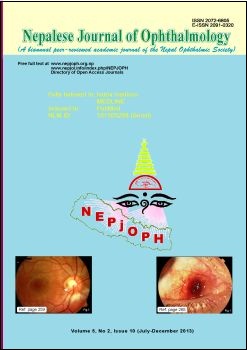Computer vision syndrome: a study of knowledge and practices in university students
DOI:
https://doi.org/10.3126/nepjoph.v5i2.8707Keywords:
Computer vision syndrome, headache, eye strain, blurred visionAbstract
Introduction: Computer vision syndrome (CVS) is a condition in which a person experiences one or more of eye symptoms as a result of prolonged working on a computer.
Objectives: To determine the prevalence of CVS symptoms, knowledge and practices of computer use in students studying in different universities in Malaysia, and to evaluate the association of various factors in computer use with the occurrence of symptoms.
Material and methods: In a cross sectional, questionnaire survey study, data was collected in college students regarding the demography, use of spectacles, duration of daily continuous use of computer, symptoms of CVS, preventive measures taken to reduce the symptoms, use of radiation filter on the computer screen, and lighting in the room.
Results: A total of 795 students, aged between 18 and 25 years, from five universities in Malaysia were surveyed. The prevalence of symptoms of CVS (one or more) was found to be 89.9%; the most disturbing symptom was headache (19.7%) followed by eye strain (16.4%). Students who used computer for more than 2 hours per day experienced significantly more symptoms of CVS (p=0.0001). Looking at far objects in-between the work was significantly (p=0.0008) associated with less frequency of CVS symptoms. The use of radiation filter on the screen (p=0.6777) did not help in reducing the CVS symptoms.
Conclusion: Ninety percent of university students in Malaysia experienced symptoms related to CVS, which was seen more often in those who used computer for more than 2 hours continuously per day.
Nepal J Ophthalmol 2013; 5(10): 161-168
Downloads
Downloads
Published
How to Cite
Issue
Section
License
This license enables reusers to copy and distribute the material in any medium or format in unadapted form only, for noncommercial purposes only, and only so long as attribution is given to the creator.




